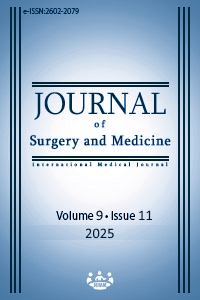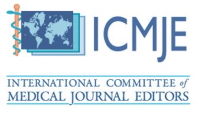Preoperative bathing with chloroxylenol versus non-medicated soap in preventing surgical site infection following inguinal herniorrhaphy
A randomized controlled trial to prevent surgical site infection
Keywords:
preoperative-bathing, chloroxylenol, non-medicated soap, surgical site infctionAbstract
Background/Aim: Surgical site infections (SSIs) remain prevalent in low- and middle-income countries, exceeding 2% even in clean procedures like elective inguinal herniorrhaphy. While preoperative bathing prevents SSIs, meta-analyses show no advantage of chlorhexidine over non-medicated soap. No studies have compared chloroxylenol soap with non-medicated soap.
Methods: We conducted a prospective randomized study of adults undergoing elective open inguinal herniorrhaphy using the Bassini technique under subarachnoid block. Patients bathed 1 h preoperatively with either chloroxylenol soap (Dettol®) or non-medicated soap (Lux®). We monitored wounds for 30 days using CDC infection criteria and analyzed data using IBM SPSS V 22.0.
Results: The study included 76 patients (93.42% male) with a mean age of 51.72 (18.70) years. The mean operative time was 49.58 (20.06) min. Right-sided hernias comprised 65.79% of cases, with 81.58% being indirect. SSI incidence was 2.63% (one patient per group), showing no significant difference between chloroxylenol and non-medicated soap (P=1.000).
Conclusion: Chloroxylenol soap offers no advantage over non-medicated soap in preventing SSIs after elective inguinal herniorrhaphy.
Downloads
References
Archampong EQ. Microbial infections in surgery. In: Archampong EQ, Naaeder SB, Ugwu BT, eds. Baja principles and practice of surgery including pathology in the tropics. 5th ed. Mumbai (IN); Repro India Ltd; 2015.p12.
Rutkow I. The rise of modern surgery: An overview. In: Towsend Mc. Evers MB, Beauchamp DR. eds. Sabiston textbook of surgery, The biological basis of modern surgical practice. 20th ed. Philadelphia (PA): Elsevier; 2017.p6-8.
Olowo-Okere A, Ibrahim YK, Olayinka BO. Epidemiology of surgical site infections in Nigeria: A systematic review of meta-analysis. Niger Postgrad Med J. 2019;26:143-51. DOI: https://doi.org/10.4103/npmj.npmj_72_19
Ramyil VM, Iya D, Ogbonna DC, Dakum NK. Safety of daycare hernia repair in Jos, Nigeria. East Afr Med J. 2000 Jun;77(6):326-8. DOI: https://doi.org/10.4314/eamj.v77i6.46647
Ohanaka EC. Textbook of core general surgery: Practice and principles. Benin City, Nigeria: Ambik press Ltd; 2016.p407-413.
Global guidelines for the prevention of surgical site infections. 2nd ed. Geneva (SW): World Health Organization: 2018.p21,59.
Centre for Disease Control (CDC). Surgical Site Infection (SSI) Event [Internet]. 2016 [cited 2019 Oct 15]. Available from https://www.cdc.gov/nhsn/PDFs/pscmanual/9pscssicurrent.pdf
Malviya VK, Sainia TK, Parma KK, Sharma S. Demographic study in operated patients with inguinal hernia. Surgical Update: Int J Surg Orthopedic. 2019;(1):20-6. doi: 10.17511/ijoso. 2019.i0104. DOI: https://doi.org/10.17511/ijoso.2019.i01.04
Awe JAA, Ugwi V, Omon EH. Inguinal Hernias: Analysis of incidence, diagnosis and management of 172 consecutive adult cases at Igbinedion University Teaching Hospital Okada. GARJMMS. 2014;3(7):168-72.
Ashindaotiang JA, Ibrahim NA, Akinlolu OO. Risk factors for inguinal hernia in adult male Nigerians. A case control study. Int J Surg. 2012;10:364-7. DOI: https://doi.org/10.1016/j.ijsu.2012.05.016
Burcharth J, Pedersen M, Bisgaard T, Pedersen C, Rosenberg J. Nationwide prevalence of groin hernia repair. PLOS One. 2013 Jan;8(1):e54367. doi: 10.1371/journal.pone.0054367. DOI: https://doi.org/10.1371/journal.pone.0054367
Yaya OS, Otekunrin OA, Ogbonna AE. Life expectancy in West African Countries: Evidence of convergence and catching up with the north. Stat. Transit. New series 2021;22(1):75-88. doi: 10.21307/stattrans-2021-004. DOI: https://doi.org/10.21307/stattrans-2021-004
OECD/European observatory on health systems and policies (2017). Denmark: Country Health Profile 2017, State of Health in the EU. OECD Publishing. Paris/European observatory on Health Systems and Policies, Brussels.
Onuigbo WIB, Njeze GE. Inguinal Hernia, A review. J Surg Oper Care. 2016;1(2):202. doi: 10.15744/2455-7617.1.202. DOI: https://doi.org/10.15744/2455-7617.1.202
Balamaddaiah G, Ramamohan Reddy SV. Prevalence and risk factors of inguinal hernia. A Study in a semi-urban area in Rayalaseema, Andhra Pradesh, India. Int Surg J. 2016 Aug;3(3):1310-33. DOI: https://doi.org/10.18203/2349-2902.isj20162208
Dogra V, Gilkar IA, Mushtaq U, et al. Incidence of inguinal hernia post- appendectomy. An observational study. J Evid Based Med Healthc. 2019;6(43):2814-7. doi: 10.18410/jebmh/2019/584. DOI: https://doi.org/10.18410/jebmh/2019/584
Ugwu-Olisa OA, Ogadi ES. Elective repair of uncomplicated inguinal hernia in South-Eastern Nigeria. Asian J Med Sci. 2016 Mar-Apr;7(2):90-5. DOI: https://doi.org/10.3126/ajms.v7i2.13349
Kumar S, Sreenivasa P. Postoperative complications and pain comparison between modified Bassini repair and Lichtenstein hernioplasty in inguinal hernia repair. Int Surg J. 2021;8(2):579-82. DOI: https://doi.org/10.18203/2349-2902.isj20210367
Zabaglo M, Sharman T. Postoperative wound infection. [Updated 2021 Mar 5]. In: StatPearls [Internet]. Treasure Island (FL): StatPearls Publishing; 2021 Jan. [cited 2021 Jun 8]. Available from https://www.ncbi.nLm.nih.gov.>NBK560533.
Ehiaghe JI, Eghiaghe FA, Nwobu RAU. Prevalence and multidrug antimicrobial susceptibility of bacteria isolates obtained from surgical sites in Nigeria. Int J Curr Microbiol App Sci. 2016;5(7):708-15. DOI: https://doi.org/10.20546/ijcmas.2016.507.081
Tayyar IAA, Al Zoubi MS, Hussein E. Prevalence and antimicrobial susceptibility pattern of coagulase negative staphylococcus (CoNS) isolated from clinical specimen in Northern Jordan. Iran J. Microbiol. 2015 Dec;7(6):294-301.
Chessa D, Ganau G, Mazzarello V. An overview of staphylococcus epidermidis and staphylococcus aureus with a focus on developing countries. J Infect Dev Ctries. 2015;9(6):547-50. doi: 10:3855/jidc.6923. DOI: https://doi.org/10.3855/jidc.6923
Downloads
- 89 93
Published
Issue
Section
How to Cite
License
Copyright (c) 2025 Akpoghor Oghenevwegba, Ugochukwu Richard Odionyeme, Agbonrofo Peter Ikponmwosa, Irowa Omorodion
This work is licensed under a Creative Commons Attribution-NonCommercial-NoDerivatives 4.0 International License.
















